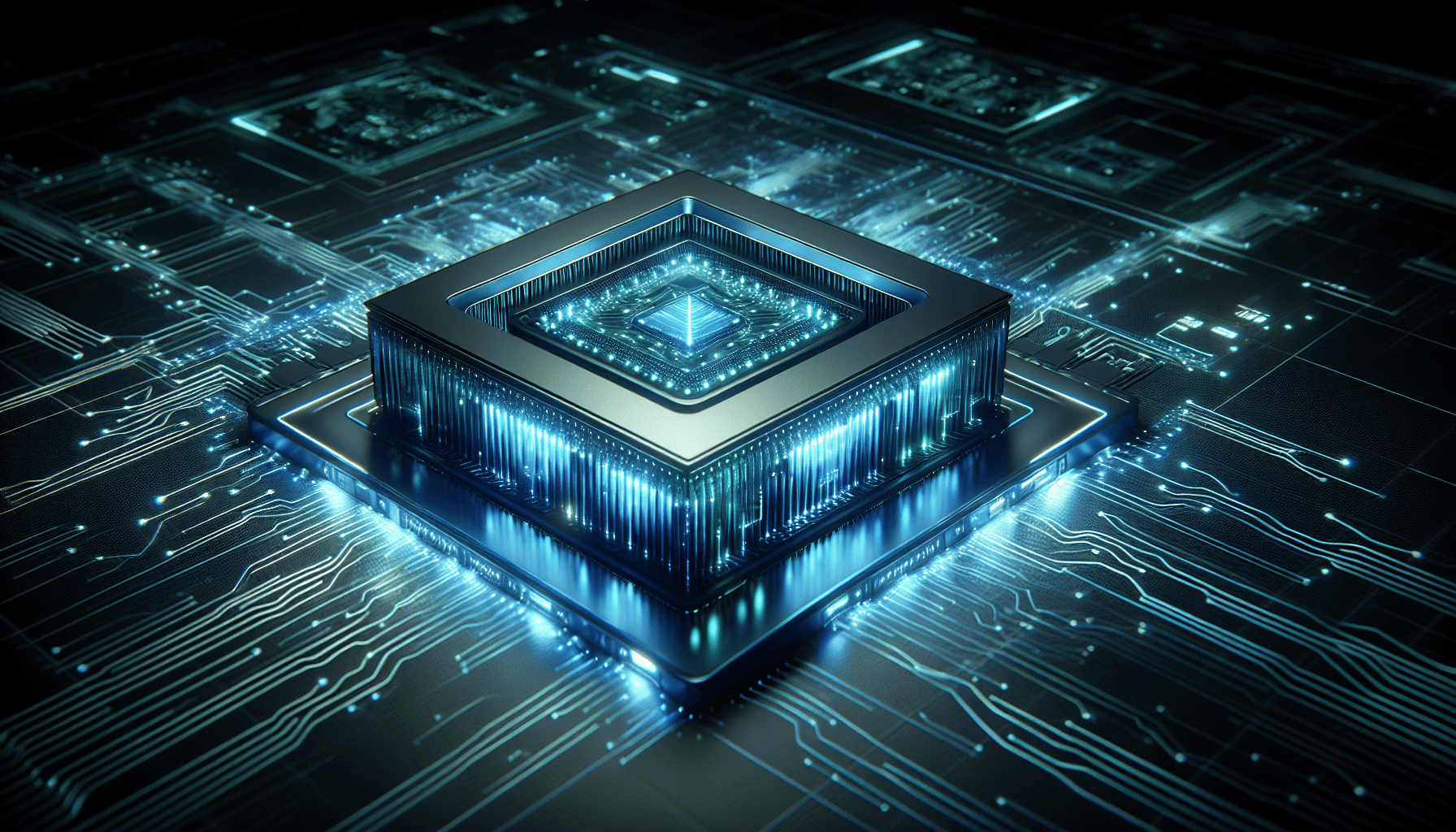Understanding What is a TPU: A Comprehensive Guide to Tensor Processing Units
The Tensor Processing Unit (TPU), a bespoke piece of hardware designed by Google, has swiftly become a game-changer in the realm of Artificial Intelligence (AI). Offering unprecedented speed and efficiency, this powerhouse of a processor has been instrumental in accelerating the progress of machine learning models. But what is a TPU, exactly, and how does it manage to outshine traditional CPUs and GPUs in AI workloads? Let’s embark on a journey to demystify this technological marvel.
Key Takeaways
Google’s Tensor Processing Unit (TPU) is an AI accelerator designed for high performance in neural network machine learning tasks, with specialized features such as the Matrix Multiply Unit (MXU) and High Bandwidth Memory (HBM) to enhance AI algorithms.
The TPU excels over general-purpose CPUs and GPUs in machine learning tasks due to its optimization for tensor operations, resulting in substantially higher data processing speeds and energy efficiency for AI applications.
TPUs have a wide range of applications across various industries, significantly speeding up and improving the efficiency of AI tasks in data centers, edge computing, and deep learning research, with ongoing developments to further integrate and evolve the TPU ecosystem.
Demystifying the Tensor Processing Unit (TPU)

Google’s Tensor Processing Unit (TPU) is an AI accelerator application-specific integrated circuit (ASIC). This specialized hardware boosts the speed of neural network machine learning tasks, central to AI technology. The TPU is not merely a processor; it’s a symbol of the significant strides that technology has made in the field of AI. It represents a revolutionary shift in how we process data and the kind of tasks we can automate with tpu tensor processing units.
The design and technological prowess of TPUs set them apart. They are equipped with a Matrix Multiply Unit (MXU), specifically designed to handle large matrix operations commonly found in AI algorithms. The TPU has undergone multiple generations of development, each time enhancing its capabilities and delivering substantial performance enhancements. This focus on performance and efficiency has seen TPUs take center stage in the world of AI, enabling faster and more efficient training and deployment of complex AI models.
The Genesis of TPUs: From Concept to Reality
Google developed the TPU in response to the escalating demands of AI and machine learning applications. The primary objective behind its creation was to develop a piece of hardware that could efficiently support Google’s demanding AI-driven services. At its core, the TPU is an application-specific integrated circuit designed to fulfill the requirements of rapidly evolving AI and machine learning applications.
The development of TPUs was driven by the need for more efficient hardware to handle the growing demands of deep learning and neural networks. Existing hardware technology, such as graphics processing units, were facing performance bottlenecks, which led to the creation of a new breed of processor optimized for machine learning tasks.
TPUs vs. Other Hardware Accelerators
TPUs excel in managing machine learning tasks. CPUs and GPUs are general-purpose processors, while TPUs are specifically designed to handle tensor operations, which are critical for deep learning models. This optimization allows TPUs to efficiently execute these operations at scale. Thanks to this specialized design, TPUs can execute these operations with exceptional efficiency, significantly outpacing traditional processors.
Moreover, TPUs offer a substantial improvement in performance, with up to 30 times faster data processing compared to traditional processors, and up to 15 times better energy efficiency for deep learning applications. But it’s not just about speed. High bandwidth memory (HBM) enables swift data access during computations, leading to a significant reduction in latency and a notable enhancement in performance for main training loop models in AI workloads.
The Symbiosis with TensorFlow
TensorFlow, Google’s open-source machine learning framework, has a close integration with TPUs, facilitating seamless deployment and optimization of machine learning models. The integration of TPUs and TensorFlow provides a platform that accelerates the training and inference phases for machine learning, resulting in a more efficient deployment and optimization of AI models.
To optimize AI models for TPUs, TensorFlow employs machine learning algorithms such as quantization, pruning, and clustering, which are integrated into the TensorFlow Model Optimization toolkit. This toolkit, along with some necessary adjustments in the TensorFlow models, allows developers to effectively utilize TPUs, thus enabling faster and more efficient development of AI applications.
Peering Under the Hood: TPU Architecture Explained

Each TPU harbors a distinctive architecture, tailored to meet the computational demands of machine learning. This architecture consists of:
8 cores, each comprising 64 32-bit Arithmetic Logic Units (ALUs)
Substantial on-chip memory to efficiently process computations
Systolic Array, a design customized to meet the intensive computational requirements of machine learning
Matrix Multiply Units (MXUs) and high bandwidth memory (HBM) to ensure efficient operation
TPUs, or application specific integrated circuits, have several unique features that make them a formidable force in the field of AI:
They have a specialized convolution engine that carries out convolution operations without the need for external memory access.
They have an instruction set that enables independent core control, effectively catering to specific machine learning tasks.
They have dynamic clocking and fine-grained clock gating for hardware optimization.
These design choices, coupled with their other capabilities, make TPUs a powerful tool for AI applications.
The Heart of the TPU: Matrix Multiply Unit (MXU)
Every TPU is centered around the Matrix Multiply Unit (MXU), which is designed to handle matrix computations models that are pivotal in machine learning endeavors. This central component is specifically engineered to manage extensive matrix operations efficiently and swiftly. The MXU is a matrix processor with the capability to perform hundreds of thousands of operations simultaneously. Its design focuses on computational throughput and efficiency in managing the intricate matrix calculations that are crucial for machine learning.
The MXU’s design is also unique. It incorporates a distinctive architecture, notably the systolic array design. This design enables a large-scale matrix processor capable of executing numerous matrix operations simultaneously, which forms the foundation of the TPU’s exceptional performance in machine learning computations.
High Bandwidth Memory (HBM) for Rapid Data Access
High Bandwidth Memory (HBM) in TPUs facilitates rapid data access during computations, playing a critical role. It leads to a substantial reduction in latency and a notable enhancement in performance for AI workloads. HBM surpasses other memory types, such as GDDR, by providing accelerated data access speeds. However, it is often associated with higher costs and potential constraints due to its 2.5D architecture.
The use of HBM in TPUs offers a substantial boost in memory bandwidth compared to conventional DDR memory. This leads to decreased latency and increased throughput in TPUs, improving the efficiency of processing AI tasks at a rapid pace. Despite some potential drawbacks, the integration of HBM into TPUs provides enhanced data access speed, resulting in improved performance for processing AI workloads.
Custom TensorFlow Operations: Maximizing TPU Utility
Developers can further exploit the utility of TPUs through custom TensorFlow operations. These operations allow developers to:
Create custom operations in C++ that can be run on TPUs
Efficiently and optimized processing of neural network workloads
Leverage the specialized architecture of TPUs to accelerate machine learning tasks and optimize performance.
The utilization of custom TensorFlow operations can significantly impact the efficiency of TPUs. By enabling developers to create custom operations in C++, the TensorFlow system can optimize AI models for TPUs. This results in quicker and more efficient predictions for IoT applications without being affected by network latency, thereby promoting the proliferation of on-device machine learning.
Real-World Impact: TPU Applications Across Industries

TPUs, impacting various industries significantly, have revolutionized our interaction with technology. Their high-performance AI acceleration capabilities have enabled faster and more efficient AI applications in data centers, edge computing, and deep learning research. From transforming data centers to facilitating the expansion of on-device machine learning with Edge TPUs, TPUs have shown their versatility and their vital role in the advancement of AI technology.
From AlphaGo to AI-driven PCB design products, TPUs have contributed to significant advancements in deep learning. Their superior performance and efficiency in training and inference of deep neural networks have made them a go-to choice for large-scale AI workloads.
Revolutionizing Data Centers with TPUs
By supplying high-performance hardware for AI workloads, TPUs are revolutionizing data centers. They facilitate the acceleration of complex calculations crucial to AI applications, leading to a substantial increase in data center compute power while optimizing power consumption.
Beyond improving performance, TPUs offer the following benefits:
Enhance AI development productivity
Optimize the performance and efficiency of neural network operations
Provide an overall enhancement in energy efficiency due to their compact, low-power design
The addition of TPUs to data centers has led to a revolution in the way data centers operate. With improved energy efficiency demonstrated by the performance of Google’s Cloud TPU v4, TPUs reduce the need for expanding data center footprints, optimizing both performance and cost for a variety of AI workloads.
Edge Computing: Bringing AI to the Edge with Edge TPU
The Edge TPU, a specialized Tensor Processing Unit variant, empowers low-power devices with AI capabilities for on-device machine learning and real-time inference. This compact ASIC delivers efficient ML inferencing while consuming minimal power, making it ideal for edge computing applications.
The Edge TPU improves edge computing by facilitating real-time processing and quick decision-making. It enables complex AI tasks to be performed locally, enhancing data privacy and reducing network reliance. From object detection to network intrusion detection and autonomous vehicles, the Edge TPU is being utilized in various real-world scenarios where its capacity to process information rapidly is crucial.
Breakthroughs in Deep Learning: TPUs in Action
TPUs have been instrumental in major deep learning breakthroughs, including AlphaGo and large-scale neural network training. For instance, AlphaGo, developed by Google’s DeepMind, used 5,000 first-generation TPUs in the training of AlphaGo Zero, demonstrating the power of TPUs in action.
Not only are TPUs used in high-profile projects like AlphaGo, but they also find application in various other deep learning projects. For example, companies like Instadeep have leveraged TPUs to enhance their AI-driven PCB design product. These applications highlight the versatility of TPUs and their potential in driving advancements in deep learning.
Navigating the TPU Ecosystem: Cloud TPUs and Beyond

Google’s TPU ecosystem is in constant evolution, with ongoing development and refinement of its hardware offerings. This ecosystem includes Google Cloud TPUs, which are specialized AI accelerators designed to efficiently handle the training and inference of large AI models. They come equipped with SparseCores architecture and are programmable, capable of executing CISC instructions across multiple neural network models.
As part of this ecosystem, Google is also considering the extension of TPU support to additional frameworks, intending to accommodate a wider array of developers and applications. This commitment to innovation and inclusivity is a testament to Google’s dedication to advancing the field of AI.
Google Cloud TPUs: Unleashing ML at Scale
Google Cloud TPUs function as supercomputers for machine learning. They offer up to 180 teraflops of performance for training and executing machine learning models, handling machine learning workloads with ease. With a specialized high-speed network, these TPUs can be formed into TPU pods, enhancing scalability and performance.
Integrated with Vertex AI, Google Cloud TPUs streamline the process for setting up and managing AI models. This integration extends to Google Kubernetes Engine (GKE) and Vertex AI systems, offering a seamless platform for AI development. Despite their superior performance, TPUs are cost-effective, making them a financially feasible option for handling intensive machine learning tasks.
Integrations and Accessibility: TPUs in the Developer Community
Integration with various AI frameworks and platforms is making TPUs increasingly accessible to the developer community. From AI Hypercomputer to TensorFlow and open-source tools like Hugging Face’s AI frameworks, TPUs are compatible with a wide array of platforms, empowering developers to accelerate their workloads and improve the training and inference of AI models.
The accessibility of TPUs has also improved over time with the introduction of Cloud TPU VMs. These VMs allow developers to execute TensorFlow, PyTorch, and JAX workloads on TPU host machines, improving performance and usability. Google’s commitment to making TPUs more accessible to developers is a testament to their commitment to advancing the field of AI.
Future Horizons: Evolving TPU Technology
TPU technology holds a promising future. Google is currently developing the TPU v5p as part of its AI Hypercomputer initiative and working on the fourth version of its custom processors. Each new iteration of the TPU brings with it improvements in performance and energy efficiency.
Looking beyond the current landscape, TPUs have the potential to be adapted for integration with or complementation of emerging technologies such as quantum computing, neuromorphic computing, and artificial intelligence. As the field of AI continues to evolve, TPUs will undoubtedly continue to play a vital role in its development.
Mastering TPU Deployment: Best Practices and Considerations

Effective TPU deployment necessitates a thorough understanding and careful consideration of their characteristics. From optimizing model performance to balancing cost and efficiency, there are several best practices and considerations that developers should keep in mind when deploying TPUs. These practices will ensure that developers are able to make the most of the TPU’s capabilities, while also managing any challenges or limitations that may arise.
Model Optimization for TPU Performance
Effective TPU utilization hinges on the optimization of AI models for TPU performance. Factors such as tensor dimensions and padding play a significant role in the performance of AI models on TPUs.
By selecting appropriate tensor dimensions that align well with the TPU’s MXU and utilizing padding to ensure efficient occupation of the entire MXU by tensors, developers can optimize model performance on TPUs.
Balancing Cost and Efficiency in TPU Utilization
When utilizing TPUs, it’s vital to strike a balance between cost and efficiency. While TPUs offer superior performance for specific tasks, they require a more substantial financial commitment compared to other hardware accelerators like GPUs. Developers need to consider the following factors to ensure cost efficiency when utilizing TPUs:
Computational power
Energy efficiency
Cost
Compatibility
Implementing a hybrid computing strategy that dynamically adjusts computational expenses can help optimize the trade-off between performance and cost for AI workloads. This, along with maximizing training resource utilization and employing autoscaling, can lead to efficiently maximizing TPU utilization.
Overcoming Challenges and Limitations
Despite their remarkable capabilities, TPUs also present their own set of challenges and limitations. From memory constraints to adaptation overhead, developers need to be aware of these challenges and how to overcome them. Strategies such as optimizing tensor layouts, adjusting batch sizes, and augmenting the quantity of TPUs to diminish communication overhead can help mitigate these challenges.
Moreover, considering economic factors and optimizing model performance can help mitigate the financial challenges associated with utilizing TPUs. With careful planning and understanding of these challenges, developers can effectively utilize TPUs and harness their full potential.
Summary
In conclusion, TPUs represent a significant leap forward in the field of AI. From their unique architecture and design to their application across various industries and their future potential, TPUs are changing the way we approach AI and machine learning. While they come with their own set of challenges and limitations, with careful planning and understanding, developers can harness the full potential of TPUs. As we continue to push the boundaries of AI, there is no doubt that TPUs will play a pivotal role in driving this progress.
Frequently Asked Questions
What is a TPU vs GPU?
In comparison, GPUs can handle complex tasks by breaking them into separate tasks, while TPUs are designed specifically for neural network loads and can work faster using fewer resources.
What is a TPU used for?
TPUs are used for a wide range of applications including textile coatings for items such as conveyor belts, inflatable products, and military equipment due to their excellent mechanical properties and chemical resistance.
Is a TPU a hardware accelerator?
Yes, a TPU is a specialized hardware accelerator designed for accelerating machine learning tasks.
How powerful is a TPU?
TPUs are designed for intensive matrix operations used in neural networks, enabling fast speeds for tasks like matrix processing and 16,000 cumulative multiplication operations per cycle. These capabilities make TPUs powerful for their specific computing tasks.
What is the relationship between TPUs and TensorFlow?
The relationship between TPUs and TensorFlow is close and symbiotic, allowing for seamless deployment and optimization of machine learning models.







